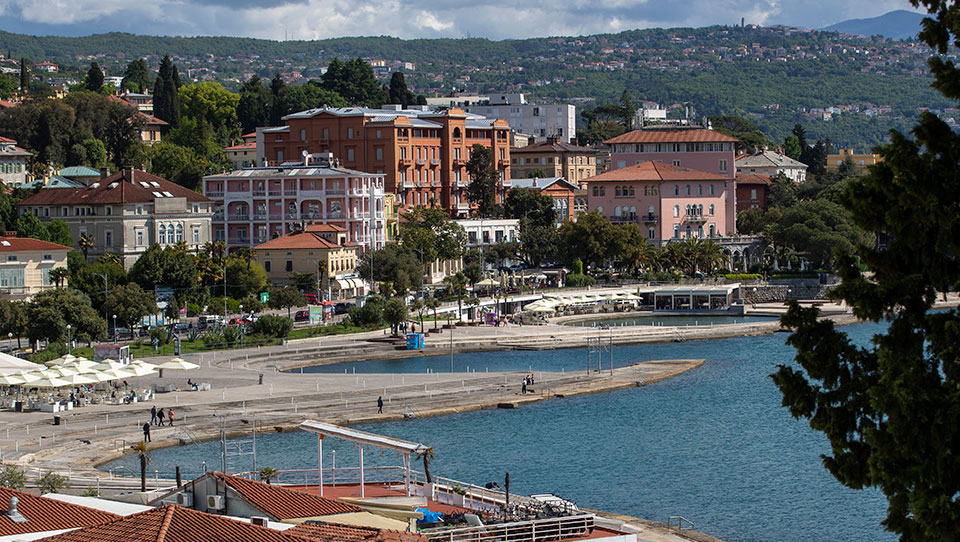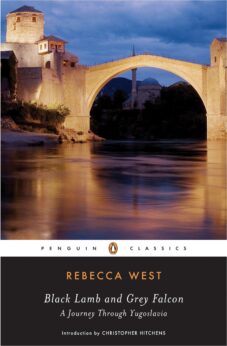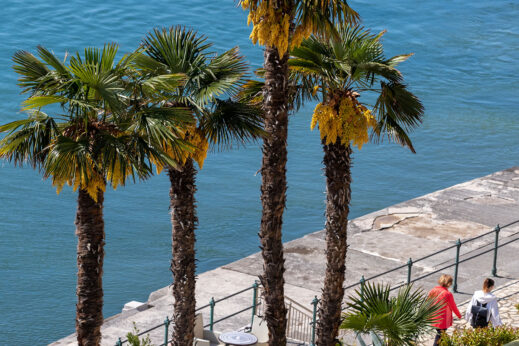
It is today one of the jewels of global tourism. The Dalmatian Coast of the still newly formed country of Croatia is back again with tourist figures this summer starting to attain pre-COVID levels in a paradise that boasts the gleaming turquoise waters of the Adriatic, the medieval walls of Dubrovnik and Zadar, the Roman ruins of Split, the magnificent waterfalls amid abundant lakes of Plitvice and Krka parks, and mini-cruises among the 700 Kornati islands.
Beneath the surface grandeur, though, lie unresolved historical and contemporary tensions which threaten to intrude upon the spectacle and make of this land a further breeding ground for a new fascism, linked to a global Trumpist far right or alternately, or at the same time, a further experiment in a red-green, socialist-ecologist coalition which may yet counter this wave both in Croatia and throughout Europe.
 Rebecca West’s monumental reckoning and sophisticated exploration of these tensions in what was then Yugoslavia in the time leading up to World War II is titled Black Lamb and Grey Falcon, with the lamb being the primarily Serbian sacrificial lamb that she hoped would not be devoured by the ominous Falcon, a Croatian symbol that in her time she feared was simply an emissary of the Italian fascist Mussolini. Today, the budding red-green lamb of Serbo-Croatian progressive unity is in danger of being swooped in on by these fascist remnants. Both, however, are also subsumed and subservient to a global capitalist takeover, with Western European money, especially prominent in the real-estate development of the Dalmatian Coast, and with signs that American and Anglo money is on the way. That money, as we have seen in the U.S. and Brazil, is not above enlisting the specter of the Black Falcon to crush the Red Lamb if its profit motive ends are threatened.
Rebecca West’s monumental reckoning and sophisticated exploration of these tensions in what was then Yugoslavia in the time leading up to World War II is titled Black Lamb and Grey Falcon, with the lamb being the primarily Serbian sacrificial lamb that she hoped would not be devoured by the ominous Falcon, a Croatian symbol that in her time she feared was simply an emissary of the Italian fascist Mussolini. Today, the budding red-green lamb of Serbo-Croatian progressive unity is in danger of being swooped in on by these fascist remnants. Both, however, are also subsumed and subservient to a global capitalist takeover, with Western European money, especially prominent in the real-estate development of the Dalmatian Coast, and with signs that American and Anglo money is on the way. That money, as we have seen in the U.S. and Brazil, is not above enlisting the specter of the Black Falcon to crush the Red Lamb if its profit motive ends are threatened.
In West’s time, “Balkans,” as she relates, was synonymous with craziness. She tells the story of a French female saloon keeper running out in the street after a Slav has shot up the mirror in her establishment screaming, “Balkans, Balkans.” In West’s view, the vaunted “craziness” is in fact a rational reaction to a land dominated in successive waves of exploitation by the Greeks, the Romans, the Germanic Huns, the Central Asian Avars, the Mongols, the Turks, the subsequent empires of Venice, France, England, Austro-Hungary, and finally the Vatican, the Italian Fascists and the Nazis.
The contemporary term that applies to this area is Balkanization, with socialist Yugoslavia—the name itself meaning “kingdom of the South Slavs”—broken up, with the aid of U.S. and NATO instigation and intervention, into six countries: Croatia, Serbia, Bosnia-Herzegovina, Slovenia, Montenegro, North Macedonia (to distinguish this now independent country from Macedonia, a bordering region of Greece), and the imperial protectorate of Kosovo. This division serves as a regressive example of tribalism and ethnic cleansing which makes each of the countries fairer game and less able to resist the massive infusion of Western investment capital that followed the breakup. It was also the blueprint which the U.S. then, aping the British in the 19th century, applied to the Middle East in what West terms, using the earlier Roman phrase, divide et impera: divide and conquer.
The Croatian view of the breakup is that, after the death of the partisan socialist Tito, who was Croatian, and the fall of the Soviet Union, the Serbs, who controlled the major military assets of the country, attacked and conquered a third of the Dalmatian Coast, wanting access to the sea. The Serb counterclaim is that they were protecting Serbs in Croatia. With a massive influx of military aid, heavily from the U.S., the Croats repulsed the Serbs and on August 4, 1995, announced the formation of the new country.
The next 25 years have seen a massive development of the coast to the point where it is now one of, if not the, top European summer vacation havens, drawing Germans in Zadar, Scandinavians to the less touristy northern city of Rijeka, Eastern Europeans who want access to a beach, and soon to be followed by Anglo celebs and money. The major tourist city Dubrovnik, whose walls are already notorious as the stand-in for King’s Landing, the major set piece on Game of Thrones, was visited this summer by Harrison Ford, after finishing shooting a fifth Indiana Jones, and by Queen drummer Roger Taylor.
A current Croatian novel, Red Water, by longtime journalist and observer of the area Jurica Pavičić, details how Irish developers enlist a former police inspector to become their agent to buy up land to turn into timeshare apartments, with the cop, for all his trouble, only offered a timeshare in the complex in the fall off-season. The Croats themselves describe these changes as a massive privatization, as they watch their own land being bought out from under them.
The three central poles of life in Croatia are family, sport, and (the Catholic) religion. On a bus coming back from Split, up the coast to Zadar, the driver, who had a patriarchal air about him, had hung over the rear-view mirror a pendant of the local soccer team Hadjuk and a wooden rosary, thus combining all three. The country punches above its weight in many areas of sport, once, for example, boasting a 28-year-old best outside shooter in the U.S. National Basketball Association, Dražen Petrović, who was tragically killed when his car slid off one of the treacherous turns on the coast.
Religion is practiced in both a tender and more mystical form than Western “symbolic” or metaphoric versions, with the worshipers in St. Simeon’s church of Zadar filing past the tomb of the saint after Sunday mass to touch it to reaffirm their faith. But the church has also been divisive. As West points out, it sponsored uniformed fascist youth movements in the 1930s as a spearhead for a possible Mussolini invasion and in general has promoted division between the Catholic Croats and the Christian Orthodox Serbs, where “there is no difference…except their religion.”
The region is now largely broken into its individual ethnic components. Croatia, at the time of the last census, was 90% Croatian, with only 4% Serbs. Croatia had been the site of two ethnic cleansings: the first, under the native Ustaŝe fascists after the Nazis invaded, carried out against Jews, Gypsies, and Serbs, and the second in the wake of the ’95 victory, perpetrated against the Serbs. Practically all that is left of a once-thriving Jewish section in the center of Split is a blown-up colorized photo of former Jewish shops and street life attached to the double doors of one of the houses.

The family-religion-sport cocktail is of course fertile breeding ground for a new fascism. This summer, along with Harrison Ford, Eastern Europe was also graced with an appearance by Fox’s Tucker Carlson, the wealthy sire to a fortune, whose fractured anti-truth telling continues the tradition of his father, a director of the U.S. propaganda outlet Voice of America. Carlson interviewed the “illiberal” head of Hungary Victor Orban, who is sponsoring a far-right global institute, not a think, but rather an “anti-thought tank,” and who, though limiting rights of a free press and in that way illiberal, is an extreme proponent of the unbridled rights of capital and in that way neoliberal. Carlson’s show featured a helicopter tour of Orban’s fence to keep out immigrants and promoted this diversion as a corporate-far right way of preoccupying the citizens of Eastern Europe, many destitute after being ravaged by Western European capital in the fallout from socialism. In Croatia, the remnants of the still quite active Ustaŝe movement are today’s Trumpist anti-vaxers who refuse the required masks in buses, the principal means of public transport.
Orban’s far-right frenzy, though, is partly a reaction to a rising progressive movement in the Balkans, with the mayor of Croatia’s capital and largest city, Zagreb, a socialist-environmentalist, part of a Red-Green coalition that came to power in the wake of a huge student movement against the wave of austerity in the wake of the 2008 Great Recession and represents a new positive reflection on the Yugoslav socialist period termed “Yugonostalgia.” There is still much enmity to overcome, as a Croatian movement contesting real estate developers in Zagreb, in attempting to link with a comparable Serbian movement over the question of the Serbian capital being emptied of its native population and turned into a luxury center on the Danube, is named “Let’s not drown Belgrade.”
The Dalmatian Coast has a long history of domination and resistance, in particular with relation to the Venetian empire. As the Venetians were beginning to assemble the ships that would allow them to become the primary force in the Mediterranean, they realized they did not have enough wood for shipbuilding. So they crossed the Adriatic—which they later referred to as “The Venice Canal”—and deforested many of the Dalmatian islands which are still today simply composed of shrubs. The ships built in the Venetian Arsenal were then used to attempt to enforce Venetian rule on the coast, including forbidding Croatian shipbuilding and taxing Croatian salt, a plentiful product of the islands, that in effect kept the people on the coast from exporting their fishing catch which they used salt to preserve.
When the cities revolted, as did Ŝibenik, whose medieval streets still stand, the Venetian ships, ironically built from Dalmatian wood, appeared in the harbor and attempted to bombard them into submission. The city states resisted, and some of them, in particular Dubrovnik, remained independent. In Zadar, in the St. Francis Monastery, named after the Italian saint who renounced his wealth and worked for the poor as depicted in the Italian director Rossellini’s biographical film, and who was supposed to have visited, there is a painted crucifix in the room next to the Sacristy where the city in the 14th century was ceded to Venice. In the 4th Crusade, the crucifix was taken to the city walls and brandished in front of the Venetian and other Western troops as a sign that the city was Christian. That did not halt the bloodthirsty crusaders who then pillaged the city anyway in an expedition, led by Venice, that never reached the Holy Land but and instead ravaged the city’s Christian rivals throughout the Mediterranean.
As Rebecca West points out, this continual reshuffling is a difficult history to overcome. But as one Zagreb activist put it, what unites these now fractured countries is not their belonging or wanting to belong to the increasingly corporatized central structure of the European Union but rather that, with the influx of Western capital, “they all belong to a semi-dominated periphery.”










